
Every four years, people interested in association football/soccer (a few billion people) talk about the FIFA World Cup™. We at COMSOL are no exception. During coffee breaks and lunches, we are discussing the different teams, players, preparations, and the tiny details that might impact the teams. The ball is an important protagonist of the games. The subject of the ball combines our passion for soccer and physics into one discussion!
Practice (with the Right Ball) Makes Perfect
The drag coefficient of a soccer ball depends on its speed, which plays an extremely important role for the precision of crosses, long-range passes, long balls, long-range shots, corner kicks, and free kicks. In modern soccer, set piece situations are often decisive for scoring. It is important that the attacking players can deliver the ball with high precision and the defending players can predict the trajectory of the ball once the ball is delivered. If the path of the ball is unusual and the players are not used to it, it will impact the outcome of the tournament.
In the FIFA World Cup™, some teams are sponsored by Adidas, maker of the FIFA World Cup™ official match ball, while some teams are sponsored by Nike, Puma, or other brands. The squads that practice with a ball other than the Adidas® Telstar® ball, the official match ball of the 2018 FIFA World Cup™, will have a disadvantage during the games if their ball performs differently. For example, the teams sponsored by Nike, such as France, Brazil, and England, could likely practice with the Nike® Ordem V. Spain, Germany, and Argentina will probably practice with the Adidas® Telstar® ball, made by their sponsor. The dilemma of training with the official ball or the team sponsor’s ball is unusually polarized this year, since three of the favored teams are sponsored by Adidas and three are sponsored by Nike!
These six teams, with the addition of Italy, cover the winners of the last 16 FIFA World Cup™ tournaments. For a winning team not on this list, we have to go back to the FIFA World Cup™ in Brazil in 1950: the heroic Uruguayan squad that delivered the “Maracanazo” and defeated Brazil in front of 200,000 spectators at the Maracaná Stadium in Rio.
In fact, the “big six” in this tournament, plus Uruguay and Italy, cover all of the world champions in the history of the FIFA World Cup™, which started in 1930. Italy, who won the cup twice since 1982 and is sponsored by Puma, did not qualify for the 2018 FIFA World Cup™ in Russia. They were eliminated in the playoffs by the hardworking and disciplined Swedish squad (sponsored by Adidas). Uruguay, also sponsored by Puma, made it to the 2018 tournament with star players in almost every position. Their team is still an unlikely match compared to the superstar squads of the big six. Another outsider is Belgium, another team with a lot of stars, sponsored by Adidas. History has shown that the possibility of winning the highest trophy is clearly limited to a few teams and there is a very large probability that the winner is among the six teams listed below!
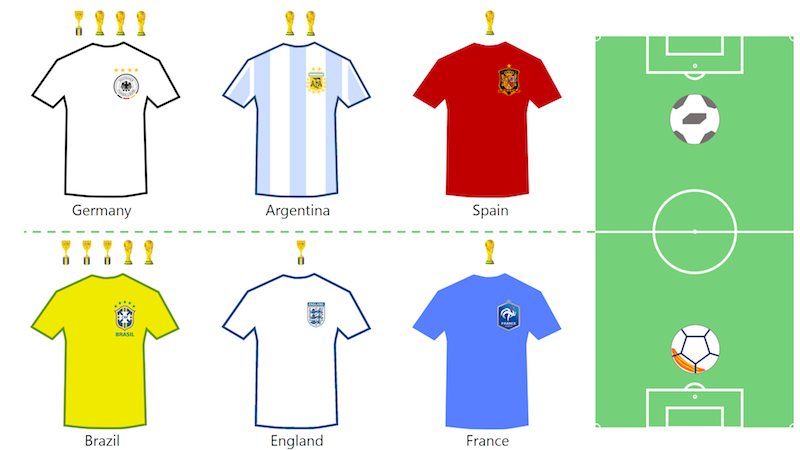
The main contenders: Germany, Argentina, and Spain are sponsored by Adidas and train with the official World Cup ball, the Adidas® Telstar® ball. Brazil, England, and France are sponsored by Nike. Will they train with the Nike® Ordem V or with the Adidas® Telstar® ball, the ball used during the games? Interesting side note: The old World Cup trophy (the Jules Rimet Trophy, used from 1930 to 1970) depicts Nike, the Greek goddess of victory.
We can estimate the possible impact of the ball on the major FIFA World Cup™ contenders by comparing the drag coefficient of the Adidas® Telstar® ball and the Nike® Ordem V. However, there is a limitation: Drag coefficients are measured in wind tunnels with advanced equipment that can measure the forces on the ball. At COMSOL, we are software developers and don’t have a wind tunnel. We also seriously doubt that we could set up a wind tunnel measurement program on short notice. Is there a way to get some kind of estimate of the drag coefficient in a more simple way?
You have probably seen YouTube videos where people attempt to levitate a soccer ball with a leaf blower. Can we use a leaf blower instead of a wind tunnel to measure and compare the drag coefficients of both balls?
The Theory Behind the Soccer Ball Experiment
To figure out if teams practicing with the Adidas® Telstar® ball will start the FIFA World Cup™ with a certain advantage, we made the following assumptions for our experiment:
- If we can suspend each ball in the air using the leaf blower, we would know that the relative speed of the air around the balls is equal to the terminal velocity of the balls. The terminal velocity is the velocity that the balls would obtain if thrown from a high altitude and let fall until they no longer accelerate as they fall.
- The terminal velocity is related to the drag coefficient of the ball. The higher the drag coefficient, the lower the terminal velocity.
- The air flow from the leaf blower is technically a turbulent jet. The velocity at the center of a turbulent jet decreases with distance from the jet outlet; in this case, the tube of the leaf blower.
- Combining assumptions 2 and 3 means that a ball with a higher drag coefficient would be suspended at a higher distance from the leaf blower’s tube compared to the ball with a lower drag coefficient.
The relation for the terminal velocity and the drag coefficient at this velocity is obtained using a balance of forces. Since the ball weighs about 80 times more than the corresponding volume of air, we can probably neglect the effect of buoyancy. Under this assumption, we arrive at a balance between the two forces to the left in the figure below.
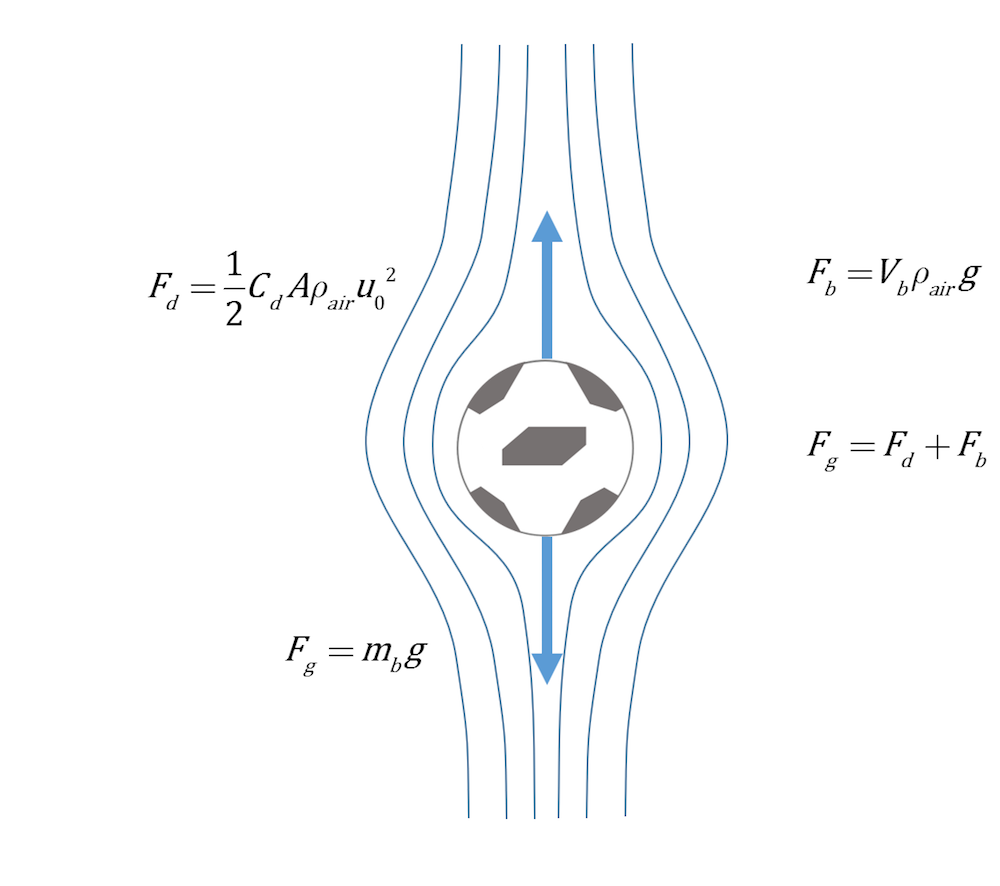
The drag force, which is directed upward, F_d, is balanced by the force of gravity directed downwards, F_g.
Here, F_d denotes the drag force, C_d the drag coefficient, A the cross sectional area of the ball, \rho_{air} the density of air, u_0 the terminal velocity of the ball, F_g the force of gravity, m_b the mass of the ball, and g the gravity constant.
The cross sectional area, the mass of the ball, and the density of air are the same, regardless of the ball we choose for the measurements. The only values that vary are C_d and u_0, since a higher value of the drag coefficient gives a lower value of the terminal velocity.
When the ball hovers above the leaf blower, the drag and gravity forces are equal in size but with opposite directions, as in the figure above. This gives the equation below:
which results in the following expression for the terminal velocity:
From this formula, we can see that a change in the value of C_d from 0.2 to 0.15 results in a change in terminal velocity of around 15%.
As a comparison, an old ball design with 32 panels should have a C_d value of around 0.2 in the regime of turbulent boundary layer separation, while the Adidas® Jabulani, used in the World Cup in South Africa, has a value of around 0.15. The Jabulani is considered to have a very unusual behavior in the air and presented some problems for players (it was especially difficult for goalkeepers to adapt to). If the Adidas® Telstar® ball has a drag coefficient that is 0.05 lower than the Nike® Ordem V, we should get a difference in terminal velocity of the order of magnitude of 15%. Such a difference would have a large impact on the squads that practice with the Nike® Ordem V during the FIFA World Cup™.
Setup for the Soccer Ball Experiment
The main idea behind the experiment is that we would place the leaf blower pointing straight up and put the ball on top of the jet. We have prepared the experiments by running some simulations in the COMSOL Multiphysics® software to predict the position of the ball at a realistic velocity delivered by the leaf blower, as shown in the figures below.
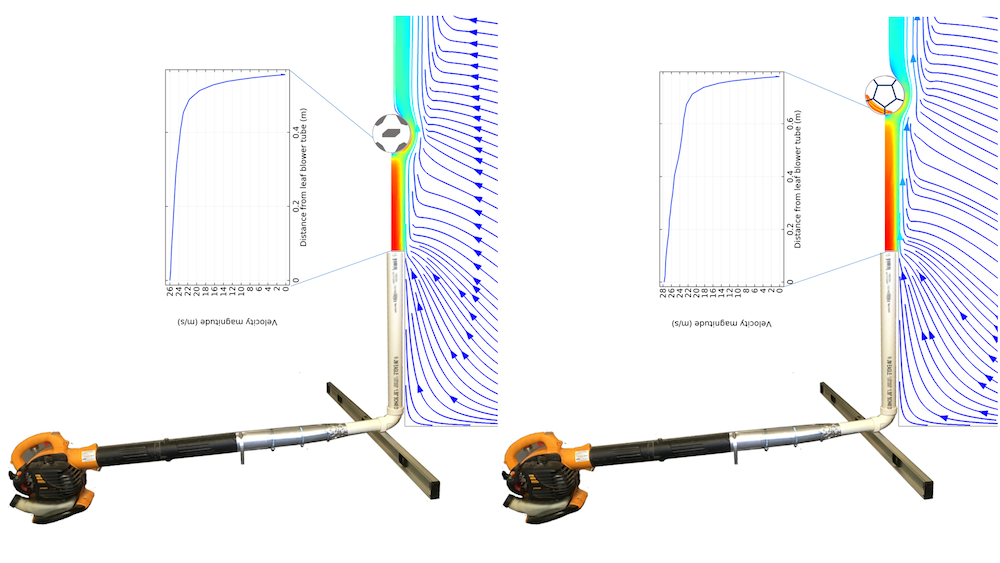
The idea behind the experiment, with a computed estimate of the distance that we are going to be able to get between the leaf blower and the two different balls. Does the Adidas® Telstar® ball differ substantially from the Nike® Ordem V?
There are doubts about the success of the leaf blower experiments.
- Where will the measured drag coefficient be along the curve for the drag coefficient as a function of the ball’s velocity?
- Will the terminal velocity be in the regime of laminar or turbulent boundary layer separation?
- How large must the difference in drag coefficient between the balls be in order for us to be able to measure a difference in distance from the leaf blower?
The figure below shows a schematic graph of the drag coefficient as a function of the ball velocity for different types of balls. The drag crisis region is between 10 and 20 m/s for a soccer ball. From the formula above, we can estimate the terminal velocity to around 35 m/s, which is in the regime of turbulent boundary layer separation, as shown in the figure below. This also corresponds to the highest velocity of the hardest long-range shots and the hardest free kicks in soccer, but the drag coefficient does not change dramatically all the way down to around 15–20 m/s, where the transition to laminar boundary layer separation may occur. So, one measured point will be representative for the ball’s drag over the whole regime of turbulent boundary layer separation. The lower part of this regime corresponds to long-range crosses, long balls, free kicks, and corner kicks.
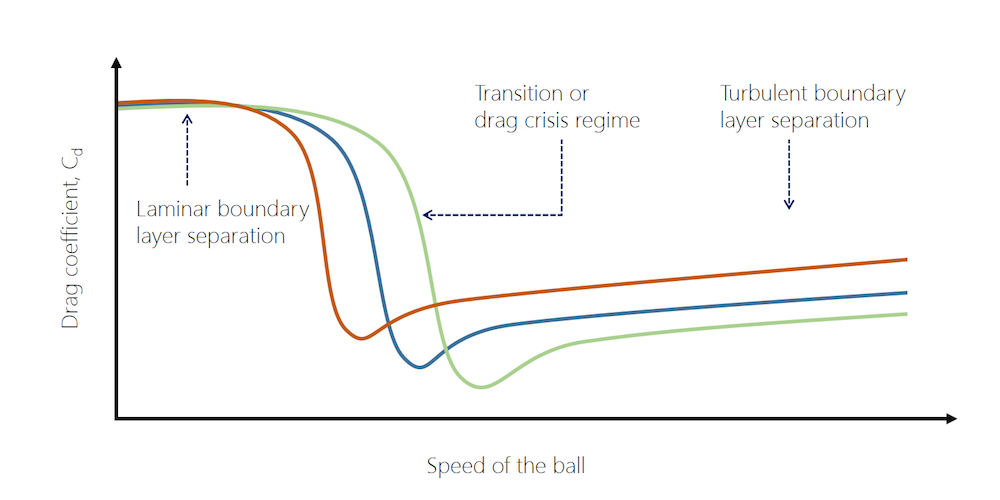
Schematic of the drag coefficient as a function of velocity. The drag coefficient does not vary much in the regime of turbulent boundary layer separation. The green curve could represent the Adidas® Jabulani, the blue curve the Adidas® Teamgeist II used in the UEFA Euro 2008™, and the red curve a typical 32-panel traditional ball, such as the first version of the Adidas® Telstar® ball used in the 1970 FIFA World Cup™ in Mexico.
We can conclude from published measurements of the drag coefficient that most long-range crosses and offensive set piece kicks are within the regime of turbulent boundary layer separation, for which the drag coefficient at the terminal velocity is representative. Our first doubt may then be discarded: even a single point on the curve gives us valuable information.
However, assume that we manage to get a leaf blower that is powerful enough to get the ball to hover about half a meter above the leaf blower’s tube. How large will the difference be in the distance of two soccer balls with a difference in drag coefficient of 0.05 at terminal velocity? Assume that the terminal velocity for the ball with the lowest drag coefficient is 40 m/s (C_d value of around 0.15). We know that the velocity of a turbulent jet decreases with the inverse of the distance from the leaf blower’s tube. Using this relation, we can estimate the change in height to be around 7–8 cm higher for the ball with the larger drag coefficient. So, from a ball with a low C_d value to a ball with a high C_d value, we should get 0.50 m and 0.58 m distances from the tube, respectively. We should be able to measure this difference!
We now know that if we are very careful, we should be able to measure a difference in the position of the Adidas® Telstar® ball and the Nike® Ordem V above the leaf blower if there is a substantial difference in their drag coefficients.
There are a few important specifications of the experiment that we have to follow:
- Pump the Adidas® Telstar® ball to the official pressure for the FIFA World Cup™ (8.5–15.6 psi) with a soccer pump that can measure pressure with high accuracy.
- Pump the Nike® Ordem V to get the same weight (or as close as possible) as the Adidas® Telstar® ball. The pressure should be almost the same. It is more important that the weight is the equal for the two balls than the pressure.
- Measure the diameter of the two balls. They should be about the same, since they are official balls, but we need to know the difference to account for it in the estimates of the drag coefficient.
- Place the leaf blower in the same position with the same angle throughout the experiment, using a spirit level to make sure that the blower tube is in a 90° angle to the ground (parallel to the direction of gravity). This is very important.
- The leaf blower should not be held by a person, since a person may disturb the airflow around the ball.
- In the suggested setup (shown below), we have to make sure that the end tube length is at least ten times the diameter in order to reduce the influence of the elbow on the flow pattern at the outlet.
- Place the camera and calibrate the distance measurements so that the camera system measures the distance from the leaf blower tube to the ball.
- The screen should be far enough from the ball to avoid disturbing the jet.
- Place the camera on a tripod in a 90° angle to the screen and keep it in the same position relative to the screen and the leaf blower.
- Place the ball above the leaf blower tube, making sure that the ball does not spin. (It should not spin at all during the experiment.)
- Run each experiment 10 times in order to get an average distance. The values may change depending on what part of the ball faces the leaf blower’s mouth.
- Make sure to record everything so that it is easy to go back and check any strange results.
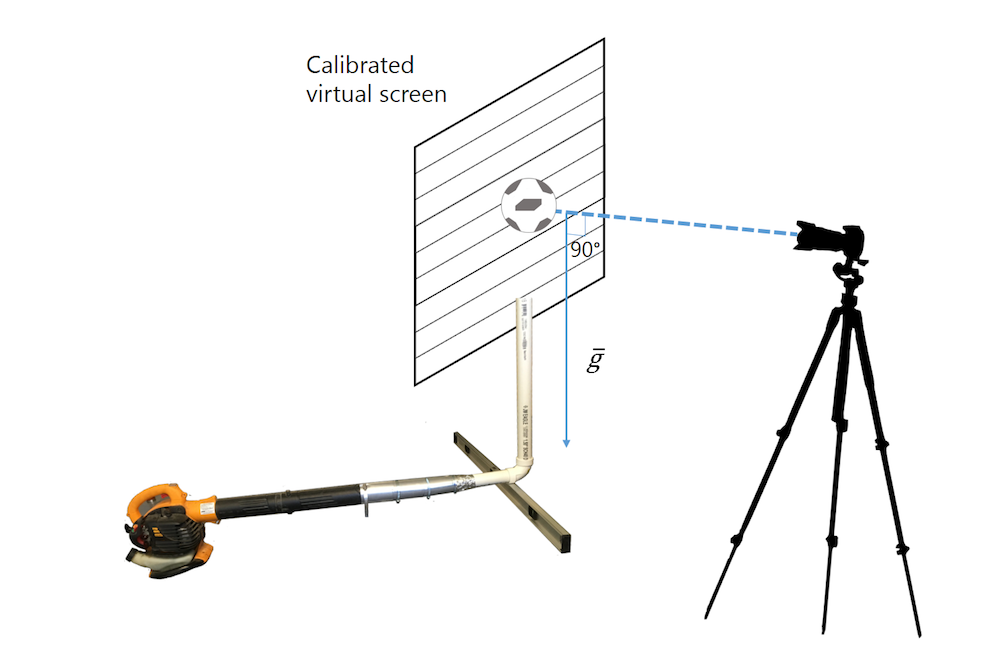
Schematic of the experiment. The screen has to be placed far enough from the ball to avoid disturbing the air jet from the leaf blower. “Camera on Tripod Silhouette” by GDJ via openclipart.
Making FIFA World Cup™ Predictions
The hypothesis is that if we are able to measure a difference in height between the Adidas® Telstar® ball and Nike® Ordem V, then it is bad news for England, Brazil, and France (the Nike®-sponsored squads), unless they practice with the Adidas® Telstar® ball during the FIFA World Cup™. Additionally, it would be good news for Germany, Spain, and Argentina (the Adidas®-sponsored squads). Obviously, if we can measure a difference, we will all bet our life savings on Germany, Spain, and Argentina.
Note that even if we do not measure a larger difference in the drag coefficient, then the drag crisis regime in which the boundary layer transitions from turbulence to laminar (when the ball slows down due to drag) is also very important for when the ball will be affected by spin (the Magnus effect) or start wobbling (the knuckle ball or beach ball effect) for a ball that has no spin. If the drag crisis comes early for the Adidas® Telstar® ball compared to the Nike® Ordem V (i.e., already at high speeds like the Adidas® Jabulani did compared to a regular soccer ball), then this may even have a greater impact than the drag coefficient. Chances are, though, that a similar drag coefficient at the turbulent regime also gives a similar velocity at the drag crisis regime. We need to think of a simple way of measuring the drag crisis, but that is for a later experiment.
Stay Tuned…
Did the England, Brazil, and France squad organizations read this blog post and make sure to practice with the Adidas® Telstar® ball for the FIFA World Cup™? We have seen reports that these teams are training with the Adidas® Telstar®ball, so they do not want to take any chances.
The preparation for our experiments are well underway. We have purchased the Nike® Ordem V and the Adidas® Telstar® ball, and we are going to rent the most powerful leaf blower that we can find. Stay tuned for the results from the experiments, as they could reveal which team will win the FIFA World Cup™…
Go Sweden! Go Uruguay!
Editor’s note, 6/6/18: The follow-up blog post, “Does It Matter Which Ball the FIFA World Cup™ Teams Practiced With?“, is now live.
Adidas is a registered trademark of adidas AG. Telstar is a registered trademark of adidas International Marketing B.V. COMSOL AB and its subsidiaries and products are not affiliated with, endorsed by, sponsored by, or supported by adidas AG or adidas International Marketing B.V.
PUMA is a registered trademark of PUMA AG. COMSOL AB and its subsidiaries and products are not affiliated with, endorsed by, sponsored by, or supported by PUMA AG.
Nike is a registered trademark of Nike, Inc. COMSOL AB and its subsidiaries and products are not affiliated with, endorsed by, sponsored by, or supported by Nike, Inc.
The UEFA word and all marks related to UEFA competitions, are protected by trademarks and/or copyright of UEFA. COMSOL AB and its subsidiaries and products are not affiliated with, endorsed by, sponsored by, or supported by UEFA.
FIFA World Cup and 2018 FIFA World Cup are trademarks of FIFA. COMSOL AB and its subsidiaries and products are not affiliated with, endorsed by, sponsored by, or supported by FIFA.



Comments (4)
Luciano Oliveira Batista
June 4, 2018Hi, I work in a ball factory in Brazil and would like to deploy an aerodynamic analysis on the balls made here. It is COMSOL software reviewable? Would it be interesting to have a joint analysis with a Wind Tunnel?
Ed Fontes
June 7, 2018 COMSOL EmployeeHi Luciano,
Yes, You can contact our Brazilian office for a trial:
info@br.comsol.com
It would be very interesting to get a full Cd curve as a function of the speed of the ball.
Best regards,
Ed
Juan Manuel Melendez
July 17, 2018Hello Dear Bastista,
At this moment I’m working with a bubble in solution electrolytic and I have to calculate the Drag force over the bubble and I don’t have the idea to do that, I would like to know some document where I can read more about the subject.
Have a good day
Best Regard
Keyvan Hassanpor
April 28, 2022Great work , I want to simulate a soccer ball drag force with comsol , Is there any tutorial for this work ?